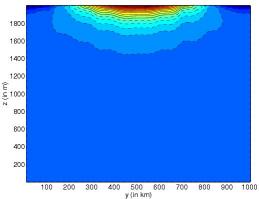The eddy-driven thermocline
(Paola Cessi - Maurizio Fantini)
The
temperature averaged over longitude and time.
The heat transport provided by time-dependent flows
with typical scales of 50km reduces the horizontal
temperature differences away from the surface,
where they are prescribed.
The heat transport provided by time-dependent flows
with typical scales of 50km reduces the horizontal
temperature differences away from the surface,
where they are prescribed.
Classical theories posit that the oceanic stratification stems from a balance between diapycnal mixing and the advection of density by the large scale circulation arising in response to the large-scale thermal and haline gradients. Diapycnal mixing occurs when internal gravity waves break and overturn a stable stratification. Breaking internal gravity waves have horizontal scales of 10 cm. The large scale meridional overturning considered by the classical theories is associated with flows on the planetery scale of 10000 km. Thus in classical theories the oceanic density structure arises from a balance between the two extreme ends of the dynamical scales in the ocean. All flows at scales intermediate between 1 cm and 10000 km are neglected.
We have demonstrated that the mean heat transport provided by time-dependent mesoscale eddies with scales of 30 to 100 km can balance the diapycnal diffusion due to breaking gravity waves and maintain a deep thermocline, shown in the figure, even without a mean circulation. This result challenges the current perspective on the dynamics of the thermohaline circulation.